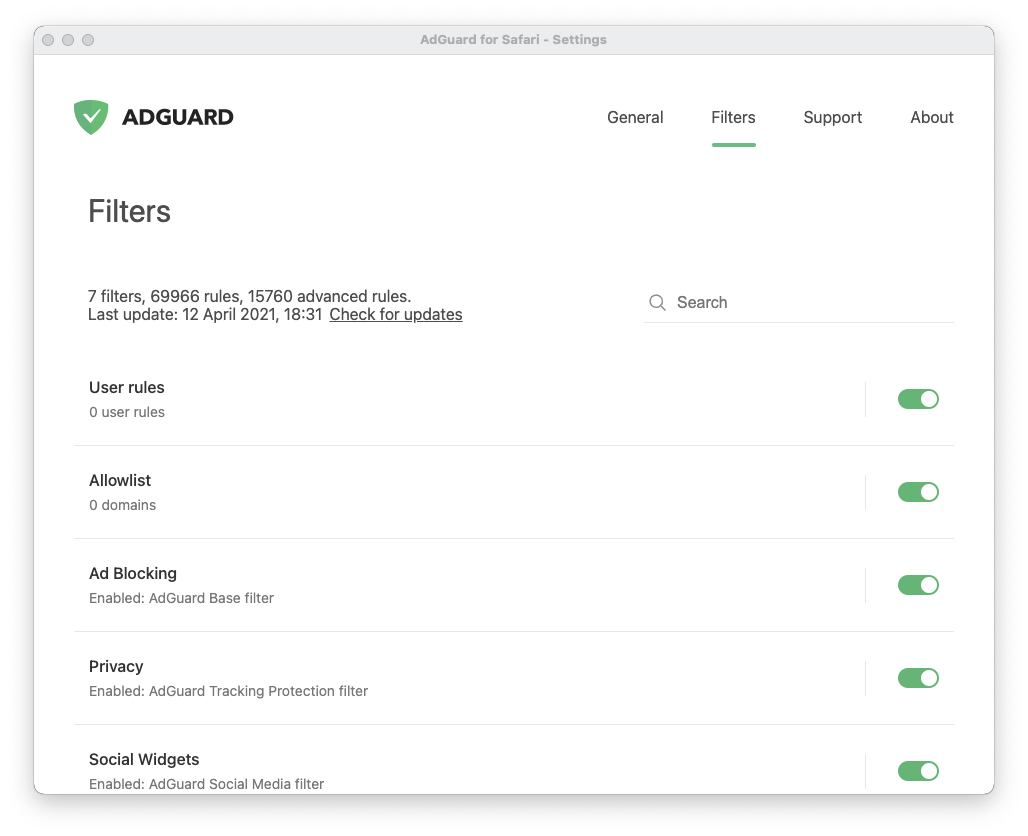The most advanced ad blocking extension for Safari
Free and open source, highly customizable and lightning fast ad blocking extension.
AdGuard.com |
Reddit |
Twitter |
Telegram



AdGuard for Safari
Ad blocking extensions for Safari are having hard time since Apple started to force everyone to use the new SDK. AdGuard extension is supposed to bring back the high quality ad blocking back to Safari.
Unlike other major ad blockers, AdGuard provides some extra features you are used to have with the traditional (now deprecated) extensions:
- Managing protection from Safari
- Choose among popular filter subscription
- Custom filters
- Creating your own filtering rules
- Manual blocking tool
- Allowlisting websites
AdGuard for Safari is based on the Safari native content blocking API, which makes it lightning fast, but somewhat limited in capabilities. For instance, Safari limits the number of rules a content blocker can have.
Better yet, there is a full-fledged AdGuard for Mac
With all above said, there is a solution that is even more effective than AG Safari extension. I mean, of course, AdGuard for Mac. It can:
- filter your traffic in all browsers and apps on your Mac
- have an unlimited number of filter rules
- provide a better filtering quality (due to the lack of browser API restrictions)
You can try it out for free.
How to build AdGuard for Safari
AdGuard for Safari consists of three parts:
- An Electron application.
- Safari Content Blocker extension
- Safari Toolbar icon extension
Prerequisites
- MacOS 10.13 or above
- Xcode 12.2 or above
- Xcode Command Line Tools
- Node.js v13.10.0 or higher
- Yarn
- JQ
Also, you need to install these packages globally:
yarn global add electron-packager
yarn global add node-gyp
yarn global add electron-osx-sign
How to build
To run application in development mode
cd ElectronMainApp
Install local dependencies by running:
yarn install
How to debug the app
Debug window
Launch the application via:
yarn start
Open menu View -> Toggle Developer Tools
Debug main process
Launch the application via
yarn inspect
Open URI chrome://inspect in Chromium
Then add a network target localhost:5858 via button "Configure" and select this target below.
Build and run in production mode
Replace the following line in file ./AdGuard/Config.xcconfig
AG_SIGN = <YOUR APPLE DEVELOPER COMMON NAME>
where <YOUR APPLE DEVELOPER COMMON NAME> is your codesign identity
Make sure your system Nodejs version higher v8.9.4.
Steps to check it:
if you use nvm run
nvm use system
node -v
otherwise
node -v
Open AdGuard.xcworkspace in Xcode and run building project
How to run tests
cd ElectronMainApp
yarn test
Preparing and building Adguard.
Environment requirements
- MacOS 10.14.4+
- Xcode 10.2+
- Dev account on developer.apple.com and
Adguard Software Limitedmembership, enabledApp Store Connect - Certificates
Developer ID Application: Adguard Software Limited (TC3Q7MAJXF)andDeveloper ID Installer: Adguard Software Limited (TC3Q7MAJXF)inkeychain
Check certificates names in Scripts/ExportOptions.plist
Building
SafariConverterLib dependency
For converting rules to content-blocker format we use an external library as a binary built from https://github.com/AdguardTeam/SafariConverterLib/, that ConverterTool binary should be placed in ./libs/.
You use ./Scripts/download-lib.sh to download the latest release version of that binary from Github.
Preparation - notarization
In case we need to notarize the app, we will need to do it.
Register in App Connect and create a password for altool.
"Because App Store Connect now requires two-factor authentication (2FA) on all accounts, you must create an app-specific password for altool, as described in Using app-specific passwords. To avoid including your password as cleartext in a script, you can provide a reference to a keychain item, as shown in the previous example. This assumes the keychain holds a keychain item named
altool_accesswith an account value matching the username[email protected]. Note that altool can’t access your iCloud keychain for security reasons, so the item must be in your login keychain. You can add a new keychain item using the Keychain Access app, or from the command line using the security utility:security add-generic-password -a "[email protected]" -w <secret_password> -s "altool_access"
Create Scripts/.devconfig.json with created username and keychain item.
Common issues
Use fixed electron-osx-sign
npm install -g electron-userland/electron-osx-sign#timestamp-server
How to release standalone builds
- update version
package.jsonandAdGuard/standalone.xcconfigorAdGuard/standalone-beta.xcconfig - build apps
- notarize builds
- publish release on Github
- refresh
updates/updates.jsonandrelease.jsonin gh-pages branch
Build application
./build.sh <channel> [--notarize=0]
Arguments:
<channel>-- updates channel:mas-- Mac App Storebeta-- standalone betarelease-- standalone release
[--notarize=0]-- optional parameter to skip notarization
Output directory build contains:
Adguard for Safari.app-- signed and notarized app.Adguard for Safari.app.zip-- zip of signed and notarized app.Adguard for Safari.xcarchive-- app archive.Adguard for Safari.xcarchive.zip-- zip of app archiveversion.txt-- version info (CI requirement).updates.json-- json file with updates info.release.json-- json file with updates info.
Clean install
- Disable all AdGuard for Safari extensions in Safari browser settings and close browser
- Close AdGuard for Safari
- Delete the following directories:
- ~/Library/Application Support/AdGuardSafariApp
- ~/Library/Containers/ - all directories started with com.adguard.safari.AdGuard (if there’s any)
- ~/Library/GroupContainers/TC3Q7MAJXF.com.adguard.safari.AdGuard
- ~/Library/Preferences/com.adguard.safari.AdGuard.plist
- Quit all “AdGuard” and “cfprefsd” processes in Activity monitor
- Reinstall AdGuard for Safari

